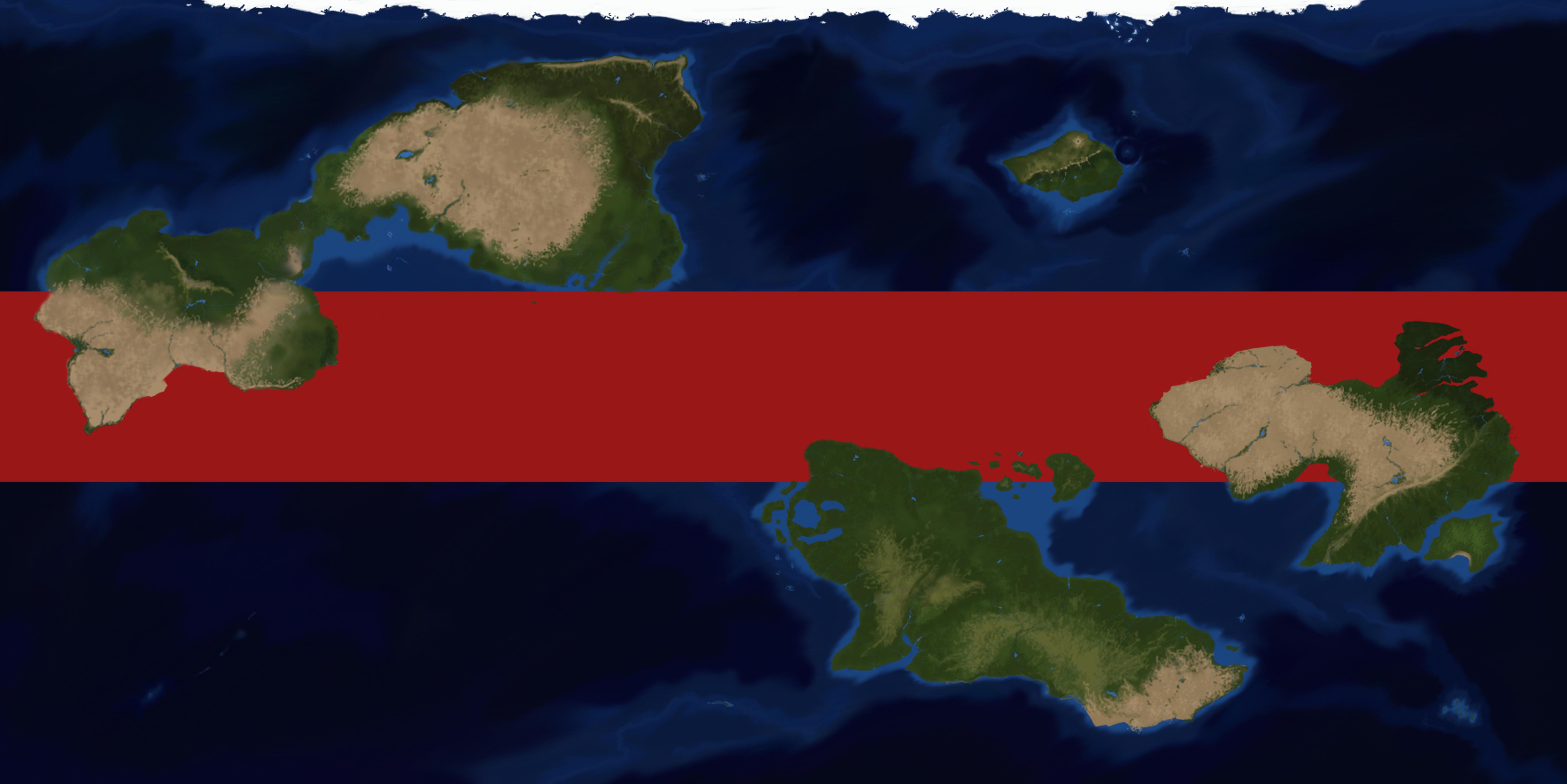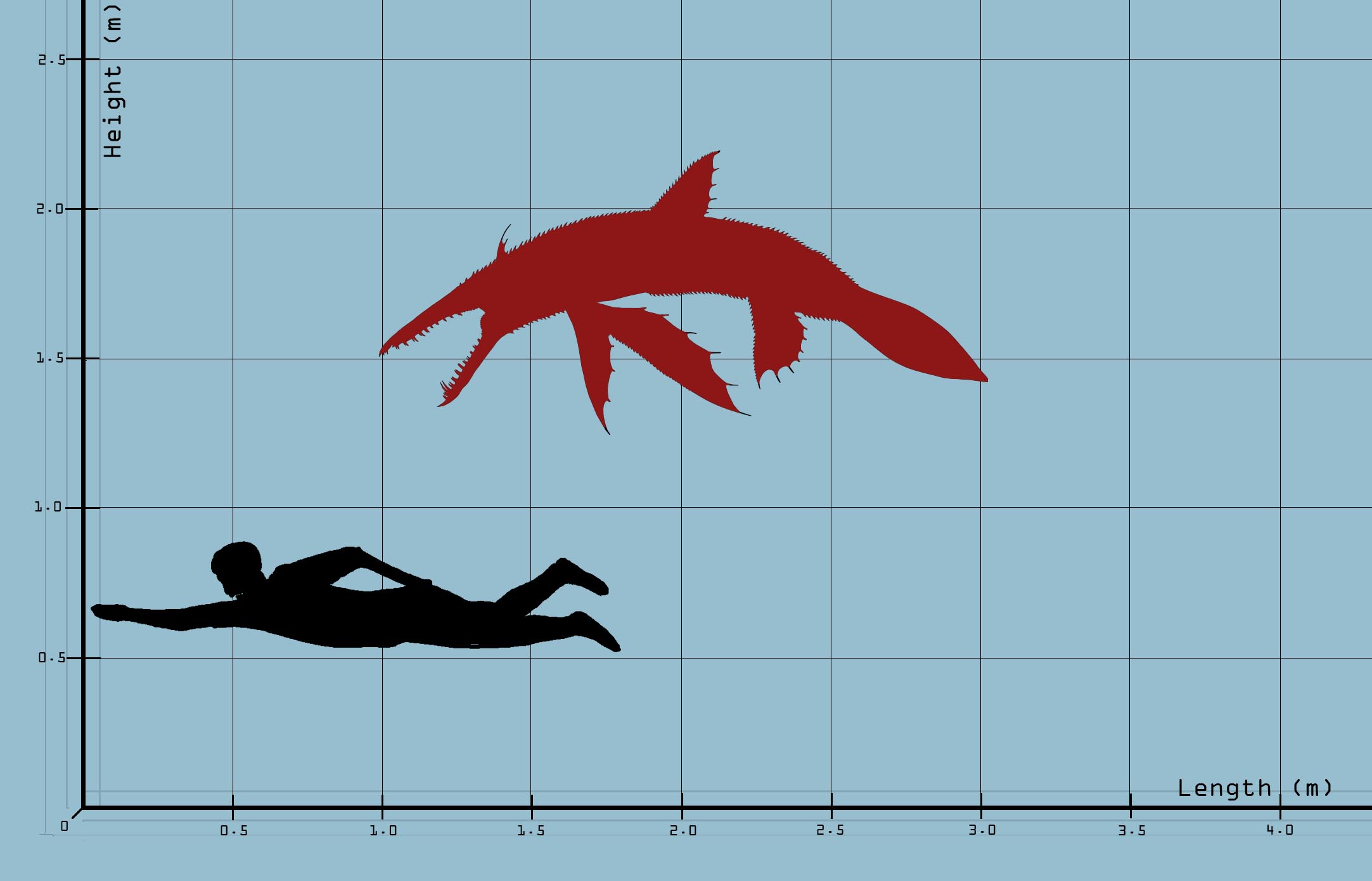Living Spear
Theothanatoxifos fulmineus is a species of fulminine pressionatatid amphibian from the open seas of the Tropical Belt.
Only genus and species under its subfamily, the Fulmininae, this animal represents one of the most derived members of its superfamily.
Perhaps most famous for the unique hunting method, the animal surely earned its place worldwide as the symbol of lethality and speed.
T. fulmineus hunts by closing all fins and propelling itself at high speeds towards prey with the two jets, piercing it from side to side, cutting through the first vertebral column and severing the vertebral cerebrum, killing the animal quickly and with sniper accuracy.
Contrary to Earth predators such were Cheetahs (†Acinonyx jubatus), T. fulmineus, like other pressionatatids, are adapted to maintaining their speeds for long distances although, once launched, they don't easily stop nor change direction.
The world-renowned status this animal enjoys attracts sport fishermen to try and capture the amphibian; given the strength and resistance of the animal, it has to be harpooned to successfully be caught, making catch & release of the species impossible.
The species' numbers have remained stable so far but marine biologists warn that if the fishing rates for the species should increase further, it would become detrimental to the environment.
T. fulmineus is reportedly very delicate and needs to be cooked slowly, however consuming the animal is illegal in many states in an attempt to avoid commercial fishing of the species.
Sometimes the species can become extremely dangerous, attacking and killing divers and fishermen, charging at boats and sinking them, dying in the process most times.
Basic Information
Anatomy
- Head elongated and thin; presence of a preorbital crest originating from the maxillo-massenteric plate border.
- Few, long and conical teeth in the mouth; incisors of both the jaw and pre-maxillary are pointed outward and enlarged, creating a blade when the mouth is closed.
- Large lanial apparatus.
- Body elongated and hydrodynamic with serrated sides; serrations made of mobile sharp osteoderms.
- Fins unusually large for a pressionatatid.
- Seven digits in the Pectoral fin, seven in Anal I, eight in Anal II and six in the Dorsal fin.
- Gill tail short and lower than body; Gill Fan long and low with a very soft caudal drop.
Genetics and Reproduction
Monogamous species.
T. fulmineus mates in Early Spring and Mid Autumn.
The animal, when receptive, releases a chemical trail in the water emitted by the jet while darting; darting is the act of accelerating to medium speed, suddenly stopping, changing course and repeating until the animal releases enough chemicals as to attract conspecifics.
Once two members of the species meet, the roles are decided; from what was observed in the wild, the Active Male tends to be the smaller of the two, while the larger one takes on the role of the passive female.
To mate, the active male has to swim belly up, keeping in close contact with the partner for the whole duration; once mating finishes, the couple stays together until the Passive females give birth, only then the active male will leave.
The Passive Female gives birth to live young as soon as they hatch inside the duct.
A T. fulmineus will nurse its babies to adulthood, teaching them how to hunt proficiently.
Specimens who don't find a mate, copulate with themselves, giving birth to parthenogenetic offspring.
An average member of the species gives birth to one to four young per mating season.
Growth Rate & Stages
Ontogenesis on the species quite marked.
Newborn specimens have no osteoderms along the length of the body and a vestigial natal aculeus; they cut through the egg through the use of the incisors instead of the aculeus.
Natal aculeus gets reabsorbed after a week from birth and the body osteoderms start to grow after two weeks.
Ecology and Habitats
Epipelagic animal found at depths between 10 and 150 m.
The animal needs open waters with plenty of light to hunt proficiently.
Dietary Needs and Habits
Active predator specialized in hunting bigger targets than itself.
Renowned for its precision, the animal pierces prey from side to side at high speeds, severing the vertebral cerebrum of prey.
By closing its fins and propelling itself with the two jets, the animal has been clocked reaching speeds of 400 km/h in 2.3 sec, enough to easily cut through prey; the bones of the head have adapted to absorb the impact without breaking, while the body carries the impact safely to the tail, stopping the animal in the process.
The animal has full control on the propulsion speed and calibrates the hit based on how big or resistant the prey is.
This hunting style comes with high risks, though; if the animal's charge isn't strong enough, they risk remaining stuck inside prey with no way out, dooming the animal to die alongside its meal.
If a member of the species misfires and hits the armour, it dies from the impact or breaks the head, severely damaging his future ability to hunt and possibly condemning it to starvation.
Biological Cycle
Periannial creature with no major dips in activity year long.
Additional Information
Social Structure
Lonesome apex predator; only exception being a mother with her young.
Domestication
Impossible to keep in captivity due to its lifestyle and hunting method.
Uses, Products & Exploitation
Of moderate importance for sportfishing.
Recommended only to very experienced anglers, the species can be extremely dangerous.
Geographic Origin and Distribution
Perception and Sensory Capabilities
Exceptional eyesight and hearing.
Symbiotic and Parasitic organisms
Afflicted by False tooth parasites.
Sometimes carry diseases, none of which transmittable to Humans.
Scientific Name
Pressionatatia; Dipressioductata; Lanceomorpha; Aceropinninoidea; Fulminolanceolatidae ; Fulmininae; Theothanatoxifos; T. fulmineus
Lifespan
40 Years
Conservation Status
Least Concern: The consuming of the animal's meat is illegal in most states to avoid the species being commercially fished. Sportfishing of the species remains into acceptable levels.
Population Trend: STABLE
Average Weight
30-100 kg
Body Tint, Colouring and Marking
Head and dorsum lime to light green, body azure to light blue.
Throat yellow, twelve lime to bright green spots along the body, in the lower ribcage area and tail.
Fins with darker blue to light purple contours.
Remove these ads. Join the Worldbuilders Guild












What do you mean with "Passive female" and "Active male"?
All pressionatatids are hermaphrodites possessing both the male and female genitalia; while selecting a mate, the two specimens define which role they will take, hence the distinction between Active males (the ones that are more active during the mating process and fertilize the eggs) and Passive females (the ones that get fertilized and are more passive during the mating process)
All right